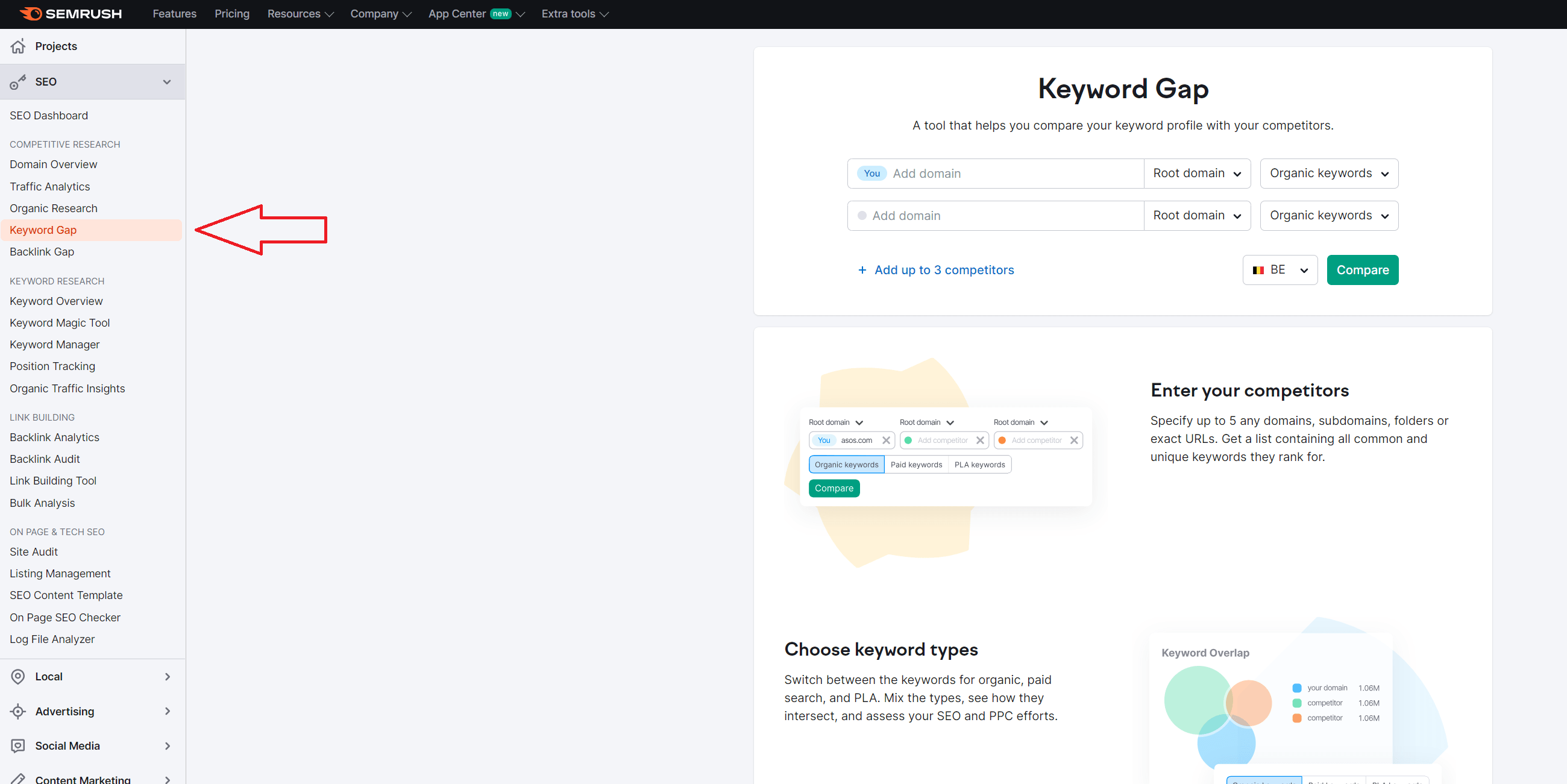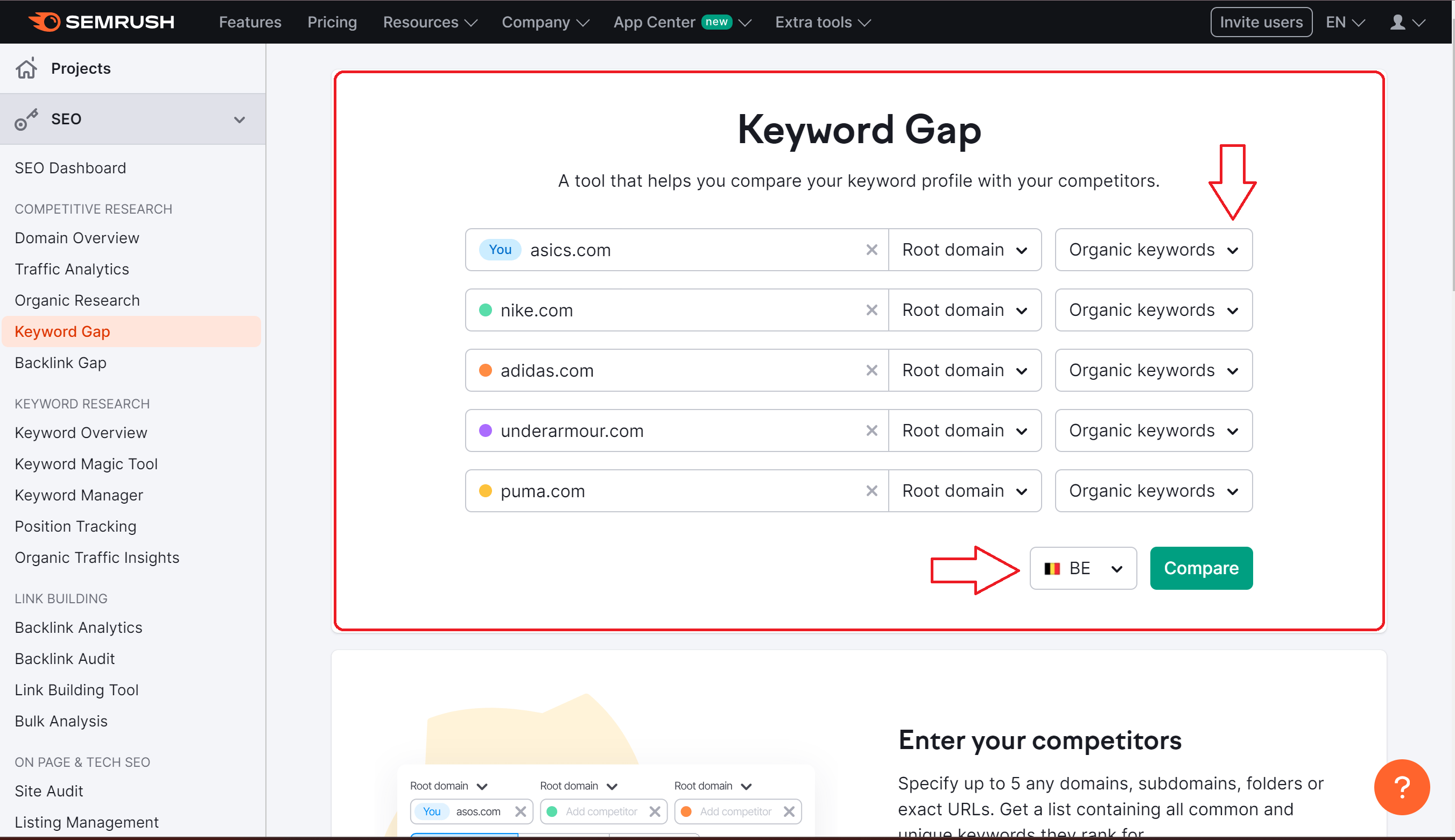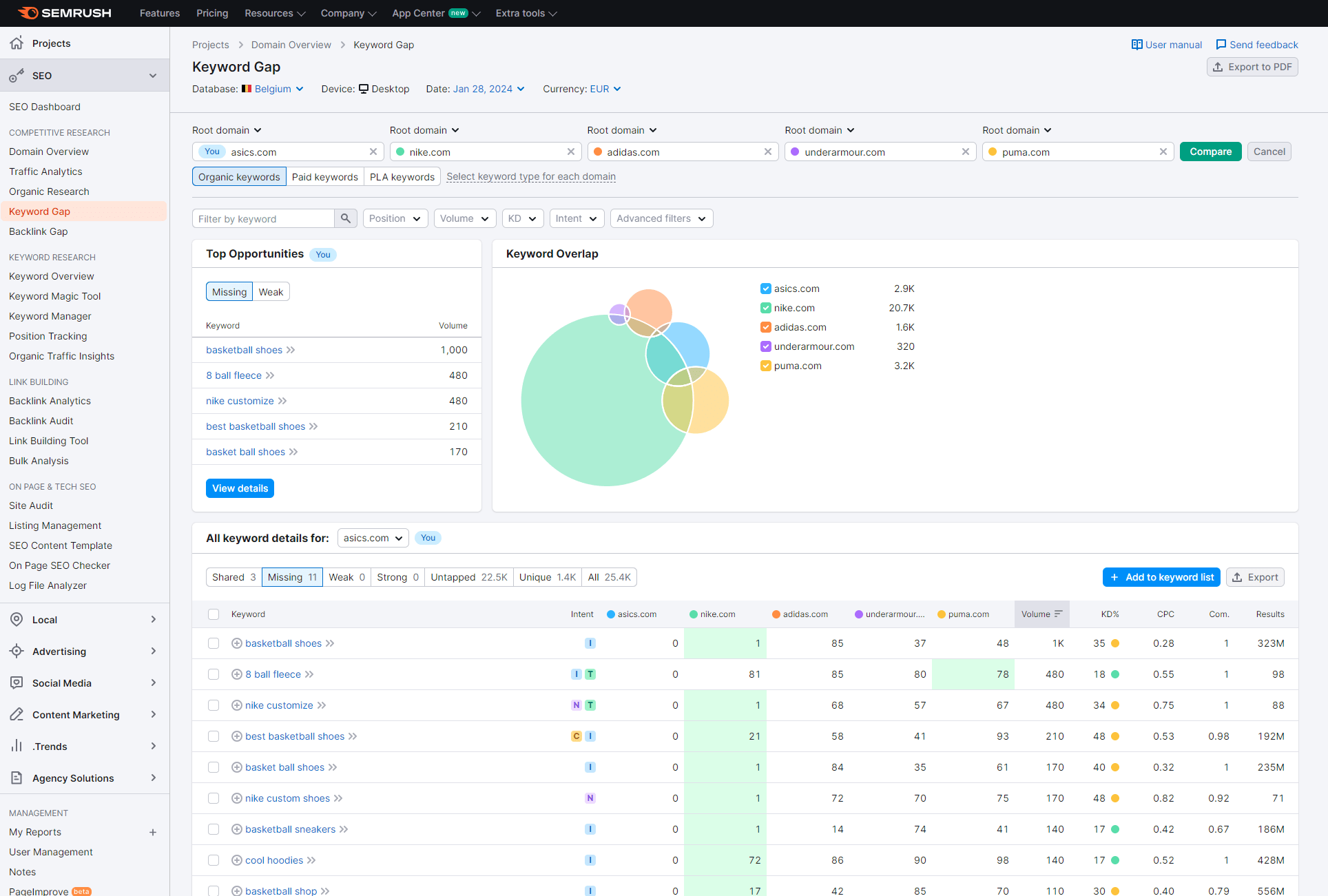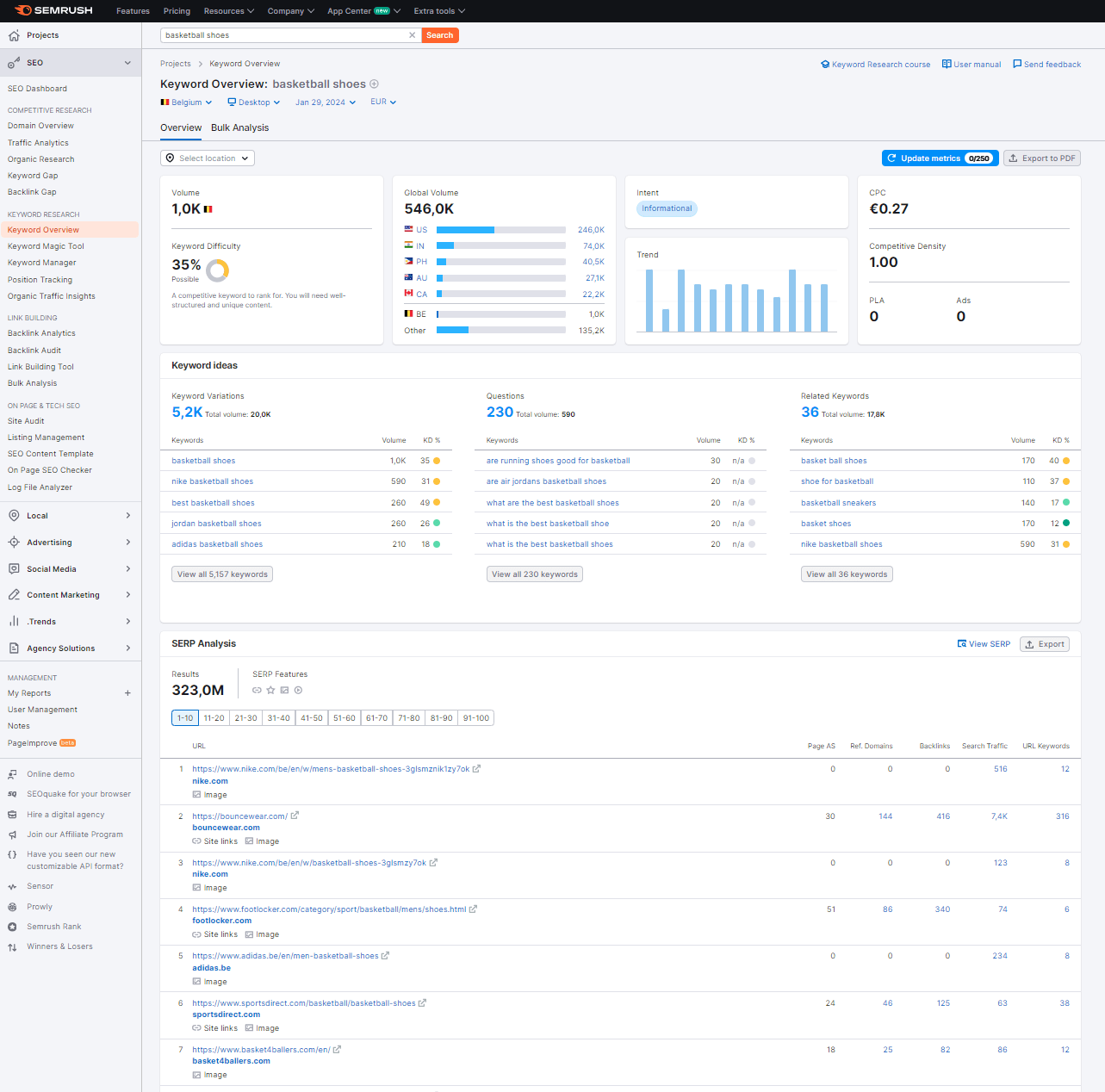Keyword analysis for SEA in SaaS
Learn how SaaS companies can use keyword analysis to build better SEA campaigns, find high-intent search terms, and improve ad performance.
Keyword Gap Analysis. Outrank competitors, attract more visitors. Learn self-analysis & optimize your SaaS website with SEMrush keyword search.
In the dynamic world of Search Engine Optimization (SEO), staying ahead of the competition is crucial. One powerful strategy to achieve this is through Keyword Gap Analysis.
This process involves comparing your website's keyword strategy with that of your competitors to uncover valuable opportunities. Let us dive together into the key aspects of this SEO technique that could give you an advantage against your competitors.

|
What is a keyword gap analysis? What are the benefits of keyword gap analysis? How to perform self-analysis using SEMRush keyword search? |
Keyword Gap Analysis is a process where you compare your website to your competitors’ website with the goal of finding keyword opportunities. You look specifically for SEO for SaaS keywords they’re using that you’re not. It can be used for both SEO and SEA. Can they make your website more visible, bring in more traffic and attract visitors from search engines?
For a deeper understanding of Keyword Gap Analysis, you might find these resources helpful:
Closing the keyword gap with your competitors brings a multitude of benefits:

There are four types of keywords you can use and understanding these various types is fundamental to this analysis. From informational and navigational to commercial and transactional, each serves a unique purpose. Analyzing keywords based on user intent provides insights into how to compete effectively in Search Engine Results Pages (SERPs).
This is when you categorize your keywords based on the type of search intent, meaning the general purpose behind the user's search query:
There are other keyword categories used in SEO. For example, local keywords are used to find nearby products or services. And long-tail keywords are highly specific search terms that are usually longer, for example "organic coffee shops near me".
But analyzing keywords based on intent can be particularly useful. It helps you understand how to compete on the Search Engine Results Pages (SERPs). The assigned intent type to a keyword can tell you whether a searcher is looking to make a purchase soon, browse around, or gather information. Explore further information about the various types of keywords by clicking here.
Want to perform your own keyword gap analysis? Then you need to start by choosing an SEO research tool. At Lead-2-Customer, we use SEMRush, so we'll use this tool to walk you through the steps. SEMRush has a special keyword search tool for analyzing competitive keywords.
In SEMRush, you can compare your website with up to four competitors. By inputting your URL (f.e. https://lead-2-customer.be/) and up to four competitor domains by your choice, SEMRush Keyword research tool provides an overview of shared, missing, and unique keywords for your website compared with these other four competitors' websites.
Let's get started! First, you should login in or create an account on SEMRush, if you haven't done so already. Once you're logged in, go to the home page of your SEMRush account, you'll see a keyword gap link in the navigation menu on the left. Click on it!

Here you'll see a dashboard where you can enter the URL of the site you're working on, as well as up to four competitor domains. Enter your URLs, choose what type of keywords you want to compare, the country you want to do your analysis in and click compare. You can select whether you want to use organic, paid or PLA keywords.
This tool will then show you the differences between your site and all four competitors. After the analysis is complete, SEMRush returns detailed results with the keywords you want to analyze.
To illustrate the concept clearly, let's use an easy example of five sports distributors and compare Asics with four of its competitors: Nike, Adidas, Under Armour and Puma.
We recommend to focus on organic keywords for this Semrush keyword gap analysis since it's easier to compare a wider variety of searches between you and your competitors. Additionally, it's important to consider the specific country you are analyzing, in this case, we use Belgium.

Once you have clicked on compare, you'll see a list of Top Opportunities and a Venn Diagram showing where you overlap with your competitors in terms of keywords. In our example, you can see the overlap between Asics and her competitors. Scroll down to view a table with all the details of your domain's keywords.
The tabs in the spreadsheet show shared, missing, weak, strong, untapped, and unique keywords. Columns reveal search intent (informative, navigational, commercial, transactional), competitor results, and statistics for each keyword (search volume, keyword difficulty, cost per click, competitive density, and results).
Search volume is the average number of searches per month. Keyword difficulty indicates ranking challenges. Cost per click is the price advertisers pay for ad clicks. Competitive density measures ad competition. Results show the number of URLs in organic search.


For example, let's look at our example where we compare "basketball shoes" with "basketball sneakers"
Next, pick a specific keyword from your list that you want to dig into. Just click on it in your Semrush keyword gap analysis.
Let's use "basketball shoes" in this example.
When you're creating content to fill in a keyword gap, think about different versions like "best basketball shoes." Also, explore related questions like "are running shoes good for basketball" and "what are the best basketball shoes." These might have lower search volumes, but they're easier to rank for, so it's worth a shot.

Is your company seeking expert assistance with Keyword Gap Analysis? Look no further! Explore our professional services!
Earlier on, we compared Asics' organic keywords with those of its competitors. But there's more to it than just the organic keywords – analyze paid keyword.
It's like peeking into what words the competition is actually spending money on. You can uncover transactional keywords for better conversions, make your Google ads work even better, and save time by focusing on what works for your nearest competitors.
So, it's a smart move to take a closer peek at both the organic and the paid keywords!
Now that you know how to perform a Semrush keyword gap analysis, it's time to find the gaps in your website's SEO. Take your time and analyze your options for the best possible SEO keywords, but remember that Search Engine Optimization is an ongoing task.
If you want to dive deeper into this topic, we have a blog featuring 10 SEO Tips to boost your website.
Keyword Gap Analysis is not a one-time task. It's an ongoing process crucial for adapting to market changes, competitor strategies, and evolving user behaviors. Regular analyses ensure your SEO strategy remains effective and your website maintains a competitive edge.
Let us do the work!
Learn how SaaS companies can use keyword analysis to build better SEA campaigns, find high-intent search terms, and improve ad performance.
SEO tips for websites: Enhance your website's SEO in 2025 with these 10 SEO tips for SaaS. Optimize page titles and more to boost your SEO rankings!
SEO for SaaS: Boost your website traffic in 2025 with effective strategies. Improve your online presence and drive growth in a competitive market.